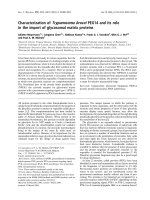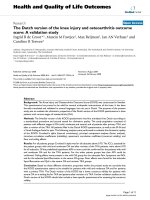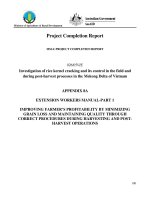Prevalence of severe mental distress and its correlates in a population-based study in rural south-west Uganda doc
Bạn đang xem bản rút gọn của tài liệu. Xem và tải ngay bản đầy đủ của tài liệu tại đây (377.63 KB, 9 trang )
RESEARCH ARTICLE Open Access
Prevalence of severe mental distress and its
correlates in a population-based study in rural
south-west Uganda
Eugene Kinyanda
1*
, Laban Waswa
1
, Kathy Baisley
2
and Dermot Maher
1,2
Abstract
Background: The problem of severe mental distress (SMD) in sub-Saharan Africa is difficult to investigate given
that a substantial proportion of patients with SMD never access formal health care.
This study set out to investigate SMD and it’s associated factors in a rural population-based cohort in south-west
Uganda.
Methods: 6,663 respondents aged 13 years and above in a general population cohort in southwestern Uganda
were screened for probable SMD and possible associated factors.
Results: 0.9% screened positive for probable SMD. The factors significantly associated with SMD included older
age, male sex, low socio-economic status, being a current smoker, having multiple or no sexual partners in the
past year, reported epilepsy and consulting a traditional heal er.
Conclusion: SMD in this study was associated with both socio-demograph ic and behaviour al factors. The
association between SMD and high risk sexual behaviour calls for the integration of HIV prevention in mental
health care programmes in high HIV prevalence settings.
Background
Governments in sub-Saharan Africa including those in
Uganda, Liberia and Southern Sudan are slowly realizing
that mental illness makes a significant contribution to
the overall health burden which is projected to rise.
Governments have therefore started to include mental
health in the minimum health care package to be deliv-
ered through an integrated approach in the existing
primary health care system [1-3]. Mental illness encom-
passes a broad range of conditions of varying degrees of
severity. Severe mental distress (SMD) for purposes of
this paper refers to all mental and neurological problems
that are associated with severe disturbance in behaviour,
thought or speech as seen in a sub-Saharan African
socio-cultural setting. The underlying philosophy behind
the use of this term was the need to capture all forms
of sever e psycho logical disturbances as seen at commu-
nitylevelinansub-SaharanAfricansetting,wherein
the majority, the communities still believe that these ill-
nesses are due to non-medical causes. We also desired
to use a category amendable to use by non-medical
interviewers.
SMD as conceived in this study a nd in this socio-cul-
tural setting may be due to the following causes: i)
severe mental illnesses- schizophrenia, paranoid psy-
choses and manic-depressive disorder; ii) acute transient
psychoses second ary to soci o-cultu ral stress such as the
‘brain fag syndrome’; iii) psychoses resulting from cere-
bral involvement in infectious diseases such as malaria,
typhoid fever, and HIV infection; iv) epilepsy largely due
to inadequate care at child birth, malnutrition, malaria,
parasitic diseases and head trauma; v ) post-traumatic
stress disorders secondary to conflict and civil strife,
which is endemic on the continent; vi) conversion-disso-
ciative states including mass hysteria; and vii) alcohol
and marijuana use and other drug-related problems
[4-9]. To assess SMD in this study we used a composite
question derived from the fo ur screening questions for
‘probable psychosis’ in the WHO Self Report Ques tion-
naire-25 [10]. In a study in urban Ethiopia having at
* Correspondence:
1
Medical Research Council/Uganda Virus Research Institute (MRC/UVRI)
Uganda Research Unit on AIDS, Entebbe, Uganda
Full list of author information is available at the end of the article
Kinyanda et al. BMC Psychiatry 2011, 11:97
/>© 2011 Kinyanda et al; licensee BioMed Central Ltd. This is an Open Access article distributed under the terms of the Creative
Commons Attribution License ( y/2.0), which permits unrestricted use, dist ribution, and
reproduction in any medium, provided the original work is properly cited.
least two of the four WHO Self Report Questionnaire-
25 [10] items was taken as indicative of ‘probable psy-
chosis’ (for purposes of this study taken to be equivalent
to SMD) where a prevalence of 5% SMD was obtained
[11].
Currently in most countries in sub-Saharan Africa
patients with SMD usually visit traditional hea lers (often
the only source of mental health care sought) before
seeking treatment in fo rmal health care system largely
because the predominant community attitudes to mental
illness is that it is a spiritual rather than a medical pro-
blem [4,12,13]. Overall, more than three quarters of
patients with severe mental illness in developi ng coun-
tries do not receive treatment from the formal health
system [14]. However with increased health education of
communities and the increased availability of mental
health services through integration into general health
care, this situation is set to change.
To better plan for this trend, there is an urgent need
for research into the problem of severe mental distress
(SMD) in sub-Saharan African settings. To study this
problem in its entirety requires population-based rather
than hospital facility-based studies so as to include
those persons who are still seeking mental health care
from traditional healers.
There have been few population-based surveys of
SMD in rural communities in Africa. A large popula-
tion-based cohort in rural southwest Uganda, initially
established in 1989 for HIV surveillance, provided the
opportunity to assess community prevalence of SMD in
adults.
Methods
Setting
Since 1986 Uganda has been recovering from decades of
previous civil, political and e conomic turmoil. The esti-
mated 30 million population are mostly engaged in sub-
sistence agriculture. Annual Gross National Income is
$300 per capita and mean lifeexpectancyatbirthis50
year s [15]. It is one of the countries in Africa where the
HIV epidemic was first reported and that was initially
most badly affect ed by HIV. The country has few psy-
chiatrists (30 in number), fewer psychologist and psy-
chiatric social workers with most of these confined to
the capital city of Kampala and a few other urban cen-
tres. Outside the capital city of Kampala, formal mental
health care is mainly provided by approximately 150
psychiatric clinical officers (physician assistants with a
diploma in psychiatry) and psychiatric nurses [2,3,16].
The mental health services in the country are arranged
around a primary health care model built on the inte-
gration of mental health care into a decentralized
health-care delivery system at district level, t hrough a
system of Health Centres (HC) starting at village level,
HC-I; subcounty level, HC-II; county level, HC-III; sub-
district level, HC-IV and district level, HC-V. This
health structure is supported by a referral system which
includes regional referral hospitals (which have a mental
health unit, that should be staffed by a psychiatris t) and
the national tertiary referral hospital at Butabika located
in the capital city of Kampala [2,3,17]. Traditional beliefs
about mental illness are still very strong in the country
with many patients with mental illnesses first seeking
care from traditional healers and in many cases this is
the only mental health care that they will access [12].
Study site
The cohort comprises approximately 20,000 resident s
residents w ho live in 25 neighbouring villages in south-
west Uganda a few kilometers from Lake Victoria. The
vast majority of dwelling s are distributed throughout the
countryside rather than clustered in villages, which
mainly represent administrative areas demarcated on
maps rather than population centres. The study popula-
tion are mostly subsistence farmers, whose staple diet
consists of matooke (cooking bananas) with groundnuts.
There are no tarmac roads and access may be difficult
during the rains. People live in semi-permanent struc-
tures built from locally available materials. The commu-
nity is stable and homogeneous, with most people from
the Baganda tribe, and 15% of Rwandese origin, who
are well assimilated. Religious affiliation is mostly Chris-
tian, with a significant Muslim minority (28%). Levels of
literacy are low and the main income-earning activities
are growing bananas, coffee and beans, and trading fish
[18]. HIV seroprevalence reported in this study is a
representation of the national picture [19]. HIV preva-
lence in the study area declined from 8.5% in 1990 to
6.2% in 1999/2000 but thereafter rose to 7.7% in 2004/
2005 [20].
Annual cohort survey
Since 1989 information has been collected in the ann ual
cohort survey on HIV sero-prevalence and associated
social, demographic and behavioural factors. Full details
of the cohort and annual HIV serosurvey have been
published elsewhere [21,22]. In brief, an annual house-
hold survey has been conducted since 1989, with all
study village residents eligible for inclusion. Average
annual serosurvey participation is about 60%-65%,
although a much higher percentage has ever partici-
pated. Community sensitization activities precede each
survey round, including local council briefings and vil-
lage meetings. All households are visited by, in turn, the
mapping, census and survey teams. Consenting residents
are interviewed at home in the local language by trained
survey staff and provide a bloo d sample for HIV testing.
Since 2009, the cohort has also served as a platform for
Kinyanda et al. BMC Psychiatry 2011, 11:97
/>Page 2 of 9
epidemiological studies on a range of other health pro-
blems of public health importance.
Measurement of SMD and other variables
In the 20
th
annual survey round (December 2008 -
November 2009), data were collected on the prevalence
of selected non-communicable diseases (including dia-
betes, other cardiovascular disease risk factors, and
SMD) in consenting adults (defined for the purpose of
the survey a s aged 13 years and above) [23]. Probable
SMD was assessed using a composite screening ques-
tion, ‘Is there a time(s) when you experienced distur-
bances in your behaviour, thought s or speech, e.g.
shouting, undressing, running aimlessly, hearing voices
of people who were not there?’ This question was
derived from the four screening questions for ‘probable
psychosis’ as is given in the WHO Self Report Question-
naire-25 [10]. Study participants who responded posi-
tively to this question wereadvisedtoattendtheir
nearest local health facility or the study clinic for further
assessment. Additional questionnaire information col-
lected included: sociodemographic factors; socioeco-
nomic status (SES) measured using an asset index
crea ted by combining data on 22 household possessi ons
using principal component analysis; whether a c urrent
or past regular cig arette smoker (including both
manufactured and local cigarettes); ever consulted a tra-
ditional healer; and sexual behavior. Clinical and labora-
tory assessments were undertaken for: diabetes (plasma
glucose measured using the enzymatic reference method
with hexokinase; Roche COBAS Integra 400 analyser
with Glucose HK Gen.3 reagent) [24]; hypertension [25];
HIV serostatus a nd epilepsy (possible epilepsy was
assessed using the WHO-SRQ-25 derived question, ‘ do
you have an illness characterized by recurrent episodes
of falling to the ground associated with loss of con-
sciousness ?’) [10].
Statistical methods
Data were double-entered and verified in Access. Stata
10 (Stata Corporation, College Station, USA) was used
for analyses. Age-standardised prevalence of reported
SMD was calculated by combining observed pre valence
with age-stratified population estimates from the 2008
census round.
Factors associated with the observed prevalence of
reported SMD were investigated using random effects
logistic regression to account for correlation within
households. A conceptual framework was used to con-
sider pot ential determ inants of and sequel to SMD
(Figure 1), with factors classified into th ree groups:
sociodemographic factors, behavioural and biological
factors. A final explanatory multivariable model was not
derived, since this was a cross-sectio nal study and it is
not possible to establish causality, and many factors,
such as mari tal breakdown, may be both possibl e deter-
minants of, and sequel to, reported SMD. Instead, the
association of factors of interest with repo rted SMD was
examined, after adjusting for age and sex. These two
variables were a djusted for as potentially important a
priori confounders.
Ethics
The study was approved by the Science and Ethics
Committee of th e Uganda V irus Research Institute and
by the Uganda National Council for Science and
Technology.
Results
At census, there were 4,801 males and 5,372 females
aged 13 years and older resident i n the study area and
eligible as survey participants. Of those, 2,719 (56.6%)
males and 3,959 (73.7%) females responded to the sur-
vey questionnaire (Figure 2). There was strong eviden ce
of higher SES among non-responders, with 25.0% of
non-responders in the highest socio-economic status
(SES) quintile compared with 22.6% of responders (p =
0.001). There was no evidence of a differe nce in HIV
serostatus between responders and non-responders, with
6.0% versus 6.2% being HIV seropositive, respec tively (p
= 0.78). Participation was lower in youn ger age gr oups,
for both sexes, and among women 60 years and older.
Characteristics of study respondents
The majority (68.5%) of respondents were under 40
years of ag e. About half (55.7%) had less than 7 years of
formal education and 42.8% were currently married. A
fifth (20.5%) of males, but only 1.3% of females, were
current or past regular cigarett e smokers. Three quar-
ters (75.3%) of females and 63.2% of the males were
sexually active. A small minortiy (4.2% of males and
6.0% of females) had ever consulted a traditional healer.
On clinical factors, 0.6% of males and 0.3% of females
reported they were suffering from epileptic illness. HIV
positive serostatus was 4.8% in males and 6.9% in
females. The prevalence of probable diabetes was 0.4%
in both males and females, and of probable hyperglycae-
mia was 3.0% in males and 2.8% in females. Of the
patients with severe mental distress (SMD) none of th e
males and only three of the fema les (5.7% of those with
SMD) reported that they were receiving formal medical
treatment for the SMD, so majority of people who
report SMD are not getting treatment.
Prevalence of probable severe mental distress and
associated factors
The observed prevalence of probable severe mental dis-
tress (SMD) (see Table 1) was 0.9% (95%CI = 0.6-1.1%),
Kinyanda et al. BMC Psychiatry 2011, 11:97
/>Page 3 of 9
Figure 1 Conceptual framework for the analysis.
Figure 2 Numbers of residents of study villages, adults censused and survey participants.
Kinyanda et al. BMC Psychiatry 2011, 11:97
/>Page 4 of 9
and was higher in males (1.1%, CI = 0.7-1.5) than in
females (0.7%, 95%CI = 0.5-1.0%).
In the unadjusted analysis, socio-demographic factors
with the strongest association with severe mental dis-
tress were increasing age and decreasing socio-economic
status (Table 2). Participan ts who were 40-59 years old
had nearly 4 times the odds of SMD as those under 20
years of age; however, the odds of SMD in those over
60 was similar to that in those under 20. Those who
were in the lowest socio-economic quintile had 3 times
the odds of SMD as those in the highest socio-economic
quintile. There was some evidence that females were
less likely to have SMD than males (age-adjusted OR =
0.58, CI = 0.33-1.01, p = 0.05). After adjusting for age
and sex, SES was the only sociodemographic factor that
remained associated with SMD.
In the unadjusted analysis, behavioural factors signifi-
cantly associated with SMD were: being a regular smo-
ker (OR 3.2, CI = 1.46-6.93, p = 0.008); number o f
sexual partners in the last year (those with none, or
with two or more, sexual partners were more likely to
report SMD than those with only one); and ever con-
sulted a traditional healer (OR 4.1, CI = 1.94-8.58, p =
0.001). There was no evidence that age at first sexual
encounter was associated with SMD After adjusting for
age and sex, the significant association between the
number of sexual partner s in the last year, and consult-
ing a traditional healer, with SMD remained, and there
was weak evidence of an association with smoking.
Of biological factors, there was an extremely strong
association between reported epilepsy and SMD, a rela-
tionship which remained significant even after adjusting
for age and gender (P < 0.001). There was no evidence
of an independent association with HIV serostatus,
hypertension or diabetes with SMD in this study.
Discussion
In this study in a poor rural community in southwest
Uganda, the prevalence of probable SMD was 0.9%,
similar to the 0.9% prevalence of moderate to serious
Table 1 Description of study participants responding to
the question on severe mental distress (SMD)
Males
(N = 2,719)
Females
(N = 3,959)
SOCIO-DEMOGRAPHIC/ECONOMIC
FACTORS
1
Age (years)
< 20 1037 (38.1%) 1123 (28.4%)
20-39 878 (32.3%) 1538 (38.9%)
40-59 521 (19.2%) 877 (22.2%)
≥ 60 283 (10.4%) 421 (10.6%)
Currently married
Yes 1052 (38.7%) 1806 (45.6%)
Ever married
Yes 1310 (48.2%) 2671 (67.5%)
Education level
Less than primary 167 (6.2%) 493 (12.5%)
Incomplete primary 1398 (51.5%) 1663 (42.0%)
Primary 501 (18.4%) 851 (21.5%)
Secondary or above 651 (24.0%) 949 (24.0%)
SES score quintile
Highest 560 (20.9%) 919 (23.6%)
High 607 (22.7%) 856 (22.0%)
Middle 517 (19.3%) 851 (21.9%)
Low 532 (19.9%) 781 (20.1%)
Lowest 458 (17.1%) 483 (12.4%)
BEHAVIOURAL FACTORS
2
Current regular smoker
Yes 373 (13.7%) 34 (0.9%)
Ever regular smoker
Yes 547 (20.2%) 50 (1.3%)
Age at first sex
< 15 117 (4.3%) 343 (8.7%)
15-16 317 (11.7%) 979 (24.8%)
17-18 521 (19.2%) 996 (25.2%)
19+ 492 (18.1%) 354 (9.0%)
Does not remember 271 (10.0%) 305 (7.7%)
Never had sex 1000 (36.8%) 978 (24.7%)
Partners in past year (among
sexually active)
None 328 (19.1%) 849 (28.5%)
1 987 (57.6%) 2073 (69.6%)
2+ 398 (23.2%) 55 (1.8%)
Consult traditional healer
Yes 113 (4.2%) 235 (6.0%)
CLINICAL INDICATORS
3
Reported severe mental distress
(SMD)
Yes 29 (1.1%) 28 (0.7%)
Receiving treatment for SMD
Yes 0 (-) 3 (10.7%)
Reported epilepsy
Yes 15 (0.6%) 10 (0.3%)
Table 1 Description of study participants responding to
the question on severe mental distress (SMD) (Continued)
HIV serostatus
Positive 128 (4.8%) 269 (6.9%)
1
Missing marital status for 1 male and 1 female. Missing data on education
for 2 males and 3 females. Missing SES index for 45 males and 69 females
2
Missing data on cu rrent smoking for 2 males, and on ever smoking for 8
males and 3 females. Missing data on age at first sex for 1 male and 4
females. Missing data on partners in past year for 6 males and 4 females.
Missing data on consulting a traditional healer for 13 males and 19 females.
3
Missing data on reported epilepsy for 4 males and 3 females Missing data
on reported SMD for 5 males and 10 females. Missing HIV status for 33 males
and 43 females
Kinyanda et al. BMC Psychiatry 2011, 11:97
/>Page 5 of 9
Table 2 Factors associated with reported severe mental distress among males and females ≥ 13 years old
All participants (N = 6663)
no. with reported disturbance/total (%) Unadjusted odds ratio [95% CI] Adjusted odds ratio
1
[95% CI]
SOCIO-DEMOGRAPHIC/ECONOMIC FACTORS
Age (years)
P = 0.002 P < 0.001
< 20 11/2155 (0.5%) 1 1
20-39 19/2410 (0.8%) 1.58 [0.73,3.41] 1.70 [0.78,3.70]
40-59 24/1396 (1.7%) 3.65 [1.72,7.74] 3.94 [1.84,8.48]
≥ 60 3/702 (0.4%) 0.85 [0.23,3.13] 0.88 [0.24,3.29]
Sex P = 0.10 P = 0.05
Male 29/2714 (1.1%) 1 1
Female 28/3949 (0.7%) 0.63 [0.37,1.09] 0.58 [0.33,1.01]
Ever married P = 0.09 P = 0.87
Yes 40/3971 (1.0%) 1 1
No 17/2690 (0.6%) 0.61 [0.34,1.09] 1.08 [0.43,2.74]
Education level P = 0.76 P = 0.77
Secondary/above 12/1597 (0.8%) 1 1
Primary 14/1348 (1.0%) 1.39 [0.62,3.09] 1.30 [0.57,2.94]
Some primary 27/3056 (0.9%) 1.16 [0.57,2.35] 1.21 [0.59,2.51]
Less than primary 4/657 (0.6%) 0.81 [0.25,2.59] 0.76 [0.22,2.59]
SES score quintile P = 0.005 P = 0.009
Highest 10/1476 (0.7%) 1 1
High 10/1457 (0.7%) 1.00 [0.39,2.54] 0.98 [0.38,2.53]
Middle 13/1366 (1.0%) 1.37 [0.57,3.32] 1.36 [0.55,3.36]
Low 5/1311 (0.4%) 0.55 [0.18,1.68] 0.52 [0.17,1.65]
Lowest 18/940 (1.9%) 3.10 [1.34,7.18] 2.90 [1.21,6.91]
BEHAVIOURAL FACTORS
Current regular smoker P = 0.008 P = 0.13
No 48/6254 (0.8%) 1 1
Yes 9/407 (2.2%) 3.18 [1.46,6.93] 2.03 [0.84,4.91]
Age at first sex P = 0.30 P > 0.99
< 15 5/458 (1.1%) 1 1
15-16 13/1295 (1.0%) 0.91 [0.31,2.69] 0.91 [0.29,2.83]
17-18 15/1510 (1.0%) 0.91 [0.31,2.65] 0.82 [0.27,2.52]
19+ 11/845 (1.3%) 1.22 [0.40,3.73] 0.93 [0.28,3.06]
Never had sex 11/1974 (0.6%) 0.50 [0.16,1.51] 0.97 [0.21,4.51]
Partners in past year P = 0.03 P = 0.04
None 15/1172 (1.3%) 1.81 [0.92,3.57] 2.00 [0.96,4.16]
1 22/3055 (0.7%) 1 1
2+ 9/452 (2.0%) 2.86 [1.27,6.43] 2.62 [1.06,6.44]
Consult traditional healer P = 0.001 P = 0.002
No 47/6285 (0.7%) 1 1
Yes 10/346 (2.9%) 4.08 [1.94,8.58] 3.74 [1.72,8.15]
BIOLOGICAL FACTORS
Reported epilepsy P < 0.001 P < 0.001
No 49/6634 (0.7%) 1 1
Yes 8/25 (32.0%) 147.10 [31.95,677.16] 158.75 [31.46,801.0]
HIV serostatus P = 0.76 P = 0.91
Negative 52/6191 (0.8%) 1 1
Positive 4/396 (1.0%) 1.19 [0.41,3.44] 0.94 [0.31,2.82]
Kinyanda et al. BMC Psychiatry 2011, 11:97
/>Page 6 of 9
mental disorders reported in Nigeria [14], but much
lower than the 5% prevalence reported in urban Ethiopia
using a precursor of the screening tool used in this
study [11].
This study provides important new information on the
community prevalence of SMD in a community rural
Africa. There are two main limitations. Firstly, the use
of one screening question for SMD runs the risk of
assessing for a highly non-specific entity. Secondly, this
question item has ne ver been previously validated in
this study population. The formation of the composite
screening item was largely driven by the following con-
siderations: the need for a question item that could be
used by lay interviews; and the need to limit the number
of questionnaire items in the survey. This question was
however derived from an established WHO question-
naire (WHO-SRQ-25 tool) which has been used exten-
sively in sub-Saharan Africa [10,11].
Secondly, the results of this study show that this ques-
tion had criterion validity. There is however a need to
validate this question item which may have utility as
screening tool for severe mental distress in the context
of large population-based studies where: non-mental
health professionals are used in data collection; where
mental health may be competing with other health disci-
plines for space on study questionnaires. Secondly,
because this was a cross-sectional study, it was not pos-
sible to tell the direction of association between SMD
and the investigated factors.
The socio-demographic factors found to be associated
with SMD in this study were increasing age and low
socio-economic status. A study in Ethiopia reported a
significantly increased risk of mental distress with
increasing age and with indices of low socio-economic
status [11]. Two explanations have been offered for the
association between the severe mental illness of schizo-
phrenia and low socio-economic status. In the s ocial
causation theory, the socio-environmental factors asso-
ciated with low socio-economic status (including more
life events stresso rs, increased exposure to enviro nmen-
tal and occupational hazards and infectious agents,
poorer prenatal care and fewer support resources if
stress does occur) are a cause of schizophrenia [26]. The
social selection, or drift, theory is that socio-economic
status is a consequence of the disorder -the insidious
onset of schizophrenia is believed to preclude elevating
one’s status or to cause a downward drift in status [26].
On the behavioural factors, being a current smoker,
having no or multiple sexual partners and having ever
consulted a traditional healer were associated with
SMD. After adjusting for age and sex there was a two-
fold increased odds of SMD among current regular
cigarette smokers as compared to those who were not
regula r smokers. Both Lasser and colle agues (2010) and
van Os and Kapur (2009) have reported higher rates of
cigarette smoking among persons with mental illness as
compared to population controls [27,28]. It has been
suggested that patients with the severe mental illness
of schizophrenia use nicotine to help reduce cognitive
deficits, negative symptoms or the neuroleptic side
effects [27]. The observed association between SMD
and having multiple sexual partners in this study con-
firms what has previously been reported by other
authors [29]. The association between SMD and high
risk sexual behavior has been attributed to factors asso-
ciated with SMD such as cognitive processing difficul-
ties, lack of planning, and poor social skills which place
these patients at risk [29]. The association between
SMD and no sexual partners may reflect the severe
social dysfunction associated with the severer end of
the spectrum of S MD. The association between SMD
and having previous contact with a traditional healer
can be regarded as a form of health-seeking behavior
for mental illness, a health seeking behavior that is in
agreement with the predominant spiritual explanatory
model for mental illness [4,13,14]. As has been
reported before in low income settings, only three
patients (5.7%) with SMD were receiving formal health
care for their problem in this study [14].
On clinical factors, self-report ed epilep sy was the only
factor significantly associated with SMD. The strong
association between self-reported epilepsy and SDM
could b e explained in two ways. Firstly, the confusional
state commonly associated with the post-ictal phase of
generalized seizures may lead to behavioural distur-
bances and hence epilepsy could be regarded as a cause
of SMD. Secondly, the community may not have been
able to adequately differentiate between epilepsy and
Table 2 Factors associated with reported severe mental distress among males and females ?≥? 13 years old (Continued)
Systolic BP ≥ 140 mmHg or diastolic ≥ 90 P = 0.61 P = 0.49
No 45/5106 (0.9%) 1 1
Yes 11/1488 (0.7%) 0.84 [0.42,1.66] 0.78 [0.38,1.59]
Random plasma glucose ≥ 7 mmol/L P = 0.10 P = 0.20
No 45/5778 (0.8%) 1 1
Yes 4/194 (2.1%) 2.71 [0.93,7.83] 2.19 [0.73,6.60]
1
Adjusted for age group and sex
Kinyanda et al. BMC Psychiatry 2011, 11:97
/>Page 7 of 9
SMD because of the possible overlap between SMD and
epilepsy.
Conclusion
In conclusion, this study provides a preliminary insight
into the problem of SMD in a rural comm unity in sub-
Saharan Africa. The associ ation between SMD and high
risk sexual behavior in high prevalence countries such
as those in sub-Saharan Africa calls for an u rgent need
for targeted HIV prevention measures among persons
with severe mental illness. The current practice in many
sub-Saharan African countries where epilepsy is mostly
managed by mental health services and the observation
in this study of a strong association between SMD and
epilepsy; in a socio-cultural context where neurologists
and psychiatrists will continue to be a rarity for the
foreseeable future provides additional impetus for the
need to integrate both mental health and neurological
services into primary health care. Further research is
under way using the cohort to investigate the associated
problems of major depressive disorder and alcohol
abuse/dependency.
List of abbreviations
EK: Eugene Kinyanda; LW: Laban Waswa; KB: Kathy Baisley; DM: Dermot
Maher; SMD: severe mental distress; WHO: World Health Organisation; HC:
Health Centre.
Acknowledgements
We would like to thank Medical Research Council/Uganda Virus Research
Institute (MRC/UVRI) Uganda Research Unit on AIDS who funded this study
as part of Core funding to the Observational Studies Programme of the MRC
Unit, The staff of the Observational Studies Programme who undertook the
data collection and the study participants from Kyamulibwa, Masaka district.
Author details
1
Medical Research Council/Uganda Virus Research Institute (MRC/UVRI)
Uganda Research Unit on AIDS, Entebbe, Uganda.
2
Department of
Epidemiology and Population Health, London School of Hygiene and
Tropical Medicine, London, UK.
Authors’ contributions
The authors of this manuscript made the following contributions to this
manuscript Concept: EK, DM; Data collection: LW, DM; Data analysis: LW, KB,
EK, DM; First draft: EK, LW, KB, DM; Final revision: EK, LW, KB, DM; Read and
approved final manuscript: EK, LW, KB, DM.
Competing interests
The authors declare that they have no competing interests.
Received: 12 March 2011 Accepted: 8 June 2011 Published: 8 June 2011
References
1. Ministry of Health of Uganda: National Health Policy Minister of Health;
1999.
2. Ministry of Health, Government of Southern Sudan: Health Policy for the
Government of Southern Sudan 2006-2011 [ />docs/650-09-313/annex_a.pdf].
3. Ministry of Health and Social Welfare Republic of Liberia: Basic Package of
Health and Social Welfare Services for Liberia. 2008 [ />documents/Basic-Package-of-Health-and-Social-Welfare-Services_Liberia.pdf].
4. Okasha A: Mental health in Africa: the role of the WPA. World Psychiatry
2002, 1(1):32-5.
5. Jilek WG: Cultural factors in psychiatric disorders.[http://www.
mentalhealth.com/mag1/wolfgang.html].
6. Gureje O, Owosegun O, Adebayo K, Stein DJ: The prevalence and profile
of non-affective psychosis in the Nigerian survey of mental health and
wellbeing. World Psychiatry 2010, 9:50-5.
7. Makanyengo MA, Othieno CJ, Okech VC: Consultation liaison psychiatry at
Kenyatta National Hospital, Nairobi. East Afr Med J 2005, 82(2):79-84.
8. Maling S, Todd J, Van Paal L, Grosskurth H, Kinyanda E: HIV-1
seroprevalence and risk factors for infection among first time psychiatric
admissions in Uganda. AIDS Care 2011, 23(2):171-8.
9. Musisi S, Kinyanda E: Psychiatric problems of HIV/AIDS and their management
in Africa Kampala, Fountain Publishers; 2009.
10. WHO: A user’s guide to the Self Reporting Questionnaire (SRQ) Geneva, WHO;
1994.
11. Kebede D, Alem A, Rashid E: The prevalence and socio-demographic
correlates of mental distress in Addis Ababa, Ethiopia. Acta Psychiatr
Scand 1999, 397:5-10.
12. Kinyanda E: Mental health chapter. In The Support to the Health Sector
Strategic Plan Project, Results of the Baseline survey report to provide basic
data for the development of the National Communication Strategy, for the
promotion of the National Minimum Health Care Package. Edited by:
Information Discovery and Solutions Limit. Kampala, Ministry of Health;
2004:108-132.
13. Patel V: Spiritual distress; an indigenous model of nonpsychotic mental
illness in primary care in Harere, Zimbabwe. Acta Psychiatr Scand 1995,
92:103-7.
14. The WHO World Mental Health Survey Consortium: Prevalence, severity,
and unmet need for treatment of mental disorders in the World Health
Organisation World Mental Health Surveys. JAMA 2004,
291(21):2581-2590.
15. UNICEF: The state of the world’s children UNICEF; 2008.
16. Kigozi F, Kinyanda E: Psychiatric rehabilitation today: An African
perspective. World Psychiatry 2006, 5(3):166.
17. Ndyanabangi S: Mental health policy and service delivery for HIV/AIDS:
the case of Uganda. In Psychiatric problems of HIV/AIDS and their
management in Africa. Edited
by: Musisi S, Kinyanda E. Kampala, Fountain
Publisher; 2009:334-342.
18. Nakibinge S, Maher D, Katende J, Kamali A, Grosskurth H, Seeley J:
Community engagement in health research: two decades of experience
from a research project on HIV in rural Uganda. Trop Med Int Health 2009,
14(2):190-195.
19. Uganda AIDS Commission (UAC): Rapid assessment of trends and drivers of
the HIV epidemic and effectiveness of prevention interventions in Uganda
Kampala, UAC; 2006.
20. Shafer LA, Biraro S, Nakiyingi-Miiro J, Kamali A, Ssematimba D, Ouma J,
Ojwiya A, Hughes P, Van der Paal L, Whitworth J, Opio A, Grosskurth H: HIV
prevalence and incidence are no longer falling in Southwest Uganda:
Evidence from a rural population cohort 1989-2005. AIDS 2008,
22(13):1641-9.
21. Nunn AJ, Mulder DW, Kamali A, Ruberantwari A, Kengeya-Kayondo JF,
Whitworth J: Mortality associated with HIV-1 infection over five years in
a rural Ugandan population: cohort study. BMJ 1997, 315:767-771.
22. Kengeya-Kayondo JF, Kamali A, Nunn AJ, Ruberantwari A, Wagner HU,
Mulder DW: Incidence of HIV-1 infection in adults and socio-
demographic characteristics of seroconverters in a rural population in
Uganda: 1990-1994. Int J Epidemiol 1996, 25:1077-1082.
23. Maher D, Waswa L, Baisley K, Karabarinde A, Unwin N, Grosskurth H:
Distribution of hyperglycaemia and related cardiovascular disease risk
factors in low-income countries: a cross-sectional population-based
survey in rural Uganda. Int J Epidemiol 2010, 1-12.
24. World Health Organization (WHO) and International Diabetes Foundation
(IDF): Definition and diagnosis of diabetes mellitus and intermediate
hyperglycemia: report of a WHO/IDF consultation WHO; 2006.
25. World Health Organization (WHO): International Society of Hypertension
(ISH) Writing Group. WHO/ISH statement on management of
hypertension. Journal of Hypertension 2003, 21:1983-1992.
26. Buchanan RW, Carpenter WT: Schizophrenia: Introduction and overview.
In Kaplan and Sadock’s Comprehensive textbook of Psychiatry Volume 1.
Edited by: Sadock BJ, Sadock VA. Lippincott Williams and Wilkins;
2002:1096-1110.
27. Van Os J, Kapur S: Schizophrenia. Lancet 2009, 374(9690):635-45.
Kinyanda et al. BMC Psychiatry 2011, 11:97
/>Page 8 of 9
28. Lasser K, Boyd JW, Woolhandler S, Himmelstein DU, McCormick D, Bor DH:
Smoking and mental illness. A population -based prevalence study.
JAMA 2010, 284(20):2606-10.
29. Senn TE, Carey MP: HIV, STD and sexual risk reduction for individuals
with severe mental illness: A review of the intervention literature. Curr
Psychiatry Rev 2008, 4(2):87-100.
Pre-publication history
The pre-publication history for this paper can be accessed here:
/>doi:10.1186/1471-244X-11-97
Cite this article as: Kinyanda et al.: Prevalence of severe mental distress
and its correlates in a population-based study in rural south-west
Uganda. BMC Psychiatry 2011 11:97.
Submit your next manuscript to BioMed Central
and take full advantage of:
• Convenient online submission
• Thorough peer review
• No space constraints or color figure charges
• Immediate publication on acceptance
• Inclusion in PubMed, CAS, Scopus and Google Scholar
• Research which is freely available for redistribution
Submit your manuscript at
www.biomedcentral.com/submit
Kinyanda et al. BMC Psychiatry 2011, 11:97
/>Page 9 of 9









